Table of contents
Dark chocolate coating with coconut oil is not available in stores. However, it is easy to make it yourself in organic quality - and with a little research, in raw food quality.
Use in the kitchen
There are high-quality organic chocolate coatings made from 100% raw cocoa, even in raw food quality, but these are only available online or in special shops. 4.5 To make shopping and deciding on the right product easier, we are going to cover a homemade version here. Using it in the kitchen is no more complicated, and you also have more freedom to decide on the sugar and fat content.
Fat and particularly high-quality processing turn chocolate into a couverture (chocolate coating mass). 19 Melted couverture is thinner than normal chocolate bars and is therefore much easier to coat or decorate cakes, baked goods or pralines. It is important to temper the glaze precisely (more on this in the following chapter), as this is the only way to achieve a flawless, shiny surface. If you neglect to do this, the surface can be matt, after a while gray fat crystals will be visible on the surface and the couverture will have a crumbly consistency.
Heating above 40 to 45 °C should be avoided. It is still raw. It is also important to observe the following points when processing: The chocolate must not come into contact with water under any circumstances, as this changes its fluidity. It should therefore only be diluted with water-free fats or oils (never with butter or margarine). The best possible shine of the coating can be achieved if the baked goods are covered with the chocolate coating at room temperature. Contamination from flour or cake crumbs can reduce the quality. 20
Chocolate coating is also used to make creams, such as ganache (chocolate coating cream).
Homemade preparation (make your own chocolate coating)
Ingredients: 200 g dark chocolate (at least 60% cocoa content), 50 g coconut oil (raw? organic?), optionally you can also add some coconut milk .
Preparation: For the vegan chocolate glaze with coconut oil, first prepare a water bath. To do this, fill a pot with water to about 1⁄3 full and heat it.
In the meantime, roughly chop the chocolate and put it together with the coconut oil in a bowl that fits well on the pot. Hang/place the bowl over the hot water bath. Make sure that no water gets into the bowl.
Melt the chocolate with the coconut oil slowly over a low heat, stirring frequently. Before the chocolate has completely melted, remove from the heat and stir in the last pieces.
Tempering: The optimum tempering is achieved by first melting the chocolate at a high temperature (around 45 °C). This is followed by a short cooling phase, during which the chocolate is cooled below its normal melting point to start the crystallization. If the viscosity increases (28-29 °C), this is a sign of crystallization. Before the chocolate crystallizes completely, however, the temperature is increased again to just over 30 °C (30-32 °C, depending on the type). Processing takes place at this temperature. 3
Note: If the melted chocolate coating is still too viscous, this can be compensated by increasing the fat content. It is almost impossible to achieve the chocolate coating properties of industrial quality products, as the equipment required for this is not available in the average household. A food thermometer is recommended to achieve the recommended temperature for tempering. Tempering requires practice and is rarely successful the first time.
Why do you mix coconut oil with chocolate? Coconut oil makes it easier to process chocolate into couverture. It improves the consistency and sensory properties.
You can also make a chocolate glaze with coconut oil and baking cocoa (unsweetened). Simply mix melted coconut oil, cocoa and, if necessary, a little sweetener (e.g. maple syrup ).
Vegan recipe for hemp cookies with coconut oil coating
Ingredients (approx. 50 pieces): 250 g spelt flour , 125 g oats , 50 g hemp seeds , 50 g linseed , 25 g coconut chips , 15 g cinnamon , a pinch of nutmeg , 3 cloves , 1⁄4 tsp galangal, 1⁄2 tsp salt , 1⁄2 tsp baking soda , 200 g chopped almonds , 180 g cane sugar , 200 g coconut oil , 1 lemon (organic!), for the coating: 100 g dark chocolate (70% cocoa), 10 g coconut oil
Preparation: First, warm the coconut oil so that it liquefies. For the flour mixture, grind the oats, hemp seeds, coconut chips and linseed. Now mix with the spelt flour. Also grind all the spices finely. Mix all the dry ingredients and then add the coconut oil (melted), lemon (peel and juice) and a little water.
You should chill the dough before further processing so that it becomes firmer. Then form 2-3 cm thick rolls from the dough and cut these into 1 cm thick slices. Place the dough slices with some space between them on a baking tray lined with baking paper and bake for 15-18 minutes at 160 °C. In the meantime, prepare the chocolate coating as described above. Once the cookies are baked, you can decorate them with the chocolate coating as you wish. Let the cookies cool down a little before eating them.
Vegan recipes with dark chocolate coating and coconut oil can be found under the note: " Recipes that have the most of this ingredient ".
| Not only vegans or vegetarians should read this: Vegans often eat unhealthily. Avoidable nutritional mistakes . |
Purchasing - Storage
Coconut oil is only permitted in chocolate for ice cream or similar frozen products (max. 5%). 1 The composition of chocolate coating is laid down in the European Cocoa Directive or in national regulations. According to this, they contain cocoa products and types of sugar as essential ingredients, with specified minimum amounts for cocoa butter and other cocoa ingredients. In practice, the ratio of cocoa ingredients to sugar is indicated using key figures. For example, 'Couverture 60/ 40–38' means that it contains 60% cocoa ingredients, 40% sugar and 38% cocoa butter. 20
Couverture is therefore a term that is regulated by law. 7 The composition of couverture according to the German Cocoa Regulation and the Austrian Chocolate Regulation states that couverture must contain at least 35% total cocoa solids. Of this, it must contain at least 31% cocoa butter and at least 2.5% fat-free cocoa solids. 20
Since we assume that sugar is taking over in our diet, we present a chocolate coating that uses less sugar. The homemade chocolate coating with coconut oil has the advantage that you can use high-quality organic chocolate with a high cocoa content and less sugar. You can also use just enough coconut oil to achieve the desired flowability.
Our chocolate coating, which consists of dark chocolate and coconut oil, is therefore not available in stores. However, all supermarket chains such as Coop , Migros , Denner , Volg , Spar , Aldi , Lidl , Rewe , Edeka , Hofer, Billa etc. offer ingredients for you to make your own. High-quality dark chocolate coating or its components are available in delicatessens, patisseries, health food stores, organic stores or organic supermarkets (e.g. Alnatura or Denns ) or can be found online. When shopping, look for sustainably produced cocoa and coconut products. If possible, give preference to products from controlled organic farming, as no chemical pesticides are used and the production process takes careful consideration of nature. Fair trade products usually have a higher price, which people are happy to pay for in return for compliance with certain ecological and social standards. Quality seals such as 'Rainforest Alliance' and 'UTZ Certified' ensure social and ecological standards.
The availability of chocolate coating with coconut oil (or its ingredients) varies depending on the size of the store, catchment area, etc. You can find our recorded food prices for the DA-CH countries above under the ingredient image - and by clicking you can see their development at various suppliers.
Storage tips
Cocoa products require special care when stored. Chocolate should be stored in a dry, cool, well-ventilated room, protected from light and foreign odors. Suitable storage conditions are 10–12 ◦C at 55–65% relative humidity. Chocolate products attract pests, especially cocoa, flour and dried fruit moths, cockroaches or ants. If stored poorly, the chocolate will have a slightly grey, matte surface. Sugar bloom occurs when the humidity is too high (above 75–80%) or when the air falls below the dew point. Tiny sugar molecules dissolve and can be seen on the surface. Fat bloom occurs when liquid fat separates out on the surface at higher temperatures (above 30 ◦C), which forms white spots when it solidifies again. Fat bloom can also occur when pre-crystallization (tempering) is improper. 2 Sugar bloom and fat bloom are only aesthetic problems.
To store coconut oil please follow the link.
Ingredients - Nutritional values - Calories
Dark chocolate with coconut oil is very hearty with a calorie content of 582 kcal/100g. The fat content is about 46%, of which about 30% is saturated fatty acids. The carbohydrate content is 36%, of which 19% is sugar and 8.5% is fiber. The protein content is about 6.3%. 6
Dark chocolate contains a high proportion of the trace element copper (1.4 mg/100g), of which we get enough anyway, as well as manganese (1.6 mg/100g). Manganese is essential for the formation of cartilage tissue. Chili powder and roasted peanuts have similar manganese values at 1.7 mg. But there are also foods with much higher values: e.g. hemp seeds (7.5 mg/100g) or wheat bran (12 mg/100g). 6
The iron content in dark chocolate with coconut oil is considerable at 9.6 mg/100g and is similar to that of dried tomatoes or coconut blossom sugar . Dried herbs such as thyme (123 mg/100g) have a much higher value, but you consume significantly less of it. The trace element is important for the transport of oxygen in the blood and also influences energy metabolism. 6
Dark chocolate contains magnesium at 183 mg/100g, which is comparable to paprika powder (178 mg/100g) or yeast-based spice paste (180 mg). This essential macronutrient is important for many enzymatic metabolic processes and is found in high quantities in seeds and nuts ( unpeeled hemp seeds: 700 mg/100g, linseed: 390 mg/100g). 6
Elements such as phosphorus , potassium and zinc are also present in dark chocolate. Read more about this in the nutrient table in the following section.
Cocoa beans also contain various secondary plant substances: methylxanthines such as theobromine and caffeine (3%), as well as polyphenols such as flavonoids and catechin tannins. The amount of polyphenols accounts for up to 18% of the total weight, with flavanols such as catechin and epicatechin accounting for around 90% of these polyphenols. Depending on the processing, the secondary ingredients in the dark chocolate coating can vary. Fermentation of the cocoa, which is a common processing step, reduces the flavonoid content. 3, 17 A common method of comparing the antioxidant effects of foods is the unit mg/g gallic acid equivalent (GAE). Cocoa powder contains 84 mg/g GAE. This is a high value. For example, green tea, which has good antioxidant effects, contains 83 mg/g GAE. 2,30
The complete ingredients of dark chocolate coating with coconut oil, the coverage of the daily requirement and comparison values with other ingredients can be found in our nutrient tables. In the article Nutrients explained you will get a detailed insight into the topic.
Health effects
The ingredients of the cocoa bean, such as methylxanthines, polyphenols such as flavonoids and fats, have potentially positive effects on our health: antioxidant effects, improvements in the heart and liver by inhibiting oxidative stress and inflammation. Cocoa can have a positive effect on vascular health, lowers cholesterol, increases insulin sensitivity and can improve cognitive functions and our mood. The methylxanthines in cocoa have bronchospasmolytic (relaxation/expansion of the bronchi), vasodilating (expansion of the blood vessels) and muscle relaxing properties. The flavonols have a positive effect on cerebrovascular blood flow (relating to the blood vessels of the brain) and reduce neurodegenerative processes, while epicatechin supports learning and memory processes. Cocoa also shows antiviral effects and a potential effect against the malaria pathogen Plasmodium falciparum. 9, 17
However, for dark chocolate (over 70% cocoa content), the results do not seem as clear as the first paragraph suggests. This is mainly due to the methods used in the various studies. A review study from 2021 took a closer look at the frequently cited health effects of chocolate and cocoa. The researchers found little to moderate evidence for many of the potential effects. There is a lack of high-quality studies to declare all of the described effects without a doubt. 10, 18
Cocoa, the basis for chocolate, contains a high level of antioxidants such as phenolic compounds. These compounds can be tasted as bitterness in raw cocoa. During chocolate production, these are reduced, which leads to a loss of flavonoids and antioxidants. However, research and experiments are being carried out to produce healthier chocolate that is rich in polyphenols. Fermentation significantly reduces the polyphenol content, although this varies depending on the origin of the cocoa. 21 Cocoa also contains caffeine and theobromine, although in smaller quantities than typical caffeinated drinks. 18 Theobromine belongs to the group of stimulant alkaloids that has a similar structure to caffeine. In small quantities, theobromine has a vasodilator and cardiac stimulant effect and relaxes smooth muscles (e.g. muscles of the blood vessels, digestive tract and respiratory tract). 11 Since theobromine stimulates the nervous system in a similar way to caffeine, sensitive people may have difficulty falling asleep if they consume dark chocolate late at night.
Diabetics are known to avoid sweets. However, chocolate with a high cocoa content (> 70%) causes blood sugar to rise to a lesser extent than other sugary foods. The glycemic index (GI) shows the blood sugar-raising effect of foods in numbers. The effect of glucose serves as a reference value, GI = 100. Chocolate with 70% cocoa content has a glycemic index of 22, milk chocolate 70 and wholemeal rye bread has a GI of 40. 12 Every diabetic must know or check before consumption how well or poorly chocolate is tolerated by him/her.
One study examined the effects of dark chocolate on mood and the gut microbiome. Daily consumption of chocolate with a high cocoa content significantly reduced negative emotions, which could be attributed to the polyphenol content. The researchers saw changes in the diversity of gut bacteria and were able to identify certain taxa that correlate with mood changes. A reduction in Faecalibacterium prausnitzii and an increase in Blautia were associated with mood changes. The results suggest a link between the consumption of dark chocolate, the positive change in the gut microbiome and the improvement in emotional state, although further research is needed to better understand the mechanism. 22
A study of over 29,000 men from 1988 to 2015 examined the relationship between chocolate consumption and mortality. This cohort study found that higher consumption of calorie-balanced chocolate was significantly associated with lower overall mortality, reduced risk of cardiovascular disease and cancer death. However, the optimal consumption amount still needs to be researched in more detail. 28
For information about the health effects of coconut oil, please read the ingredient coconut oil .
Dangers - Intolerances - Side effects
Cocoa butter consists of triglycerides of various, mostly saturated fatty acids (palmitic acid, stearic acid, oleic acid and linoleic acid), sterols and cholesterol. The proportion of saturated fatty acids in cocoa butter is around 60%, while in coconut oil the saturated fats are even more prevalent at 82%. In comparison, palm oil has slightly less of them at 49%. The ratio of inflammation-promoting linoleic acid (LA) to anti-inflammatory alpha-linolenic acid (ALA), or omega-6 to omega-3, is 127:1 in coconut oil, 45:1 in palm oil and 28:1 in cocoa butter. 6
These values must be observed when making dark chocolate coating with coconut oil or other vegetable fats. In addition to the studies mentioned above, it should be added that saturated fatty acids can cause permanent damage to the human body if consumed regularly. An increase in the undesirable LDL cholesterol in the blood promotes cardiovascular diseases. 13 It is questionable to what extent the positive effects of chocolate on the cardiovascular system compensate for the negative ones.
Ready-made chocolate coating often contains soy lecithin. Soy is one of the eight most common allergens. 14
Allergies to the cocoa in chocolate are rare. This is due, among other things, to the manufacturing process. It is not clear what effect less processed cocoa has. 8
In addition to the well-known harmfulness of sugary products for teeth, chocolate also has addictive potential due to the interaction of fat and sugar, the expectations of consumers and the pleasure of eating. Read more about this in the summary of the book "Salt Sugar Fat" by Michael Moss .
Dogs and cats must not eat chocolate. The theobromine it contains can lead to poisoning and be fatal for animals (including cattle, other livestock and bears). Other products from the cocoa tree (eg the shell of the cocoa bean as garden litter) can also have serious consequences due to their theobromine content. 15 The most common cases of poisoning occur in dogs, as they are attracted to the aroma of cocoa.
Folk medicine - natural healing
In folk medicine, cocoa shells are used for kidney and bladder problems. Due to their constipating effect, they are also used for diarrhoea and for liver and gallbladder problems. 17
Ecological footprint - animal welfare
The CO₂ footprint of dark chocolate is 3.74 kg CO 2 eq/kg. 23 However, this value can vary depending on the ingredients and country of origin. Milk chocolate comes to 5.1 kg CO₂/kg. 27
Water footprint: The cocoa tree requires different amounts of water depending on the growing area and cultivation method (agroforestry systems vs. monocultures). Dark chocolate performed better in a life cycle analysis than white chocolate and milk chocolate. 25 The global average water footprint of chocolate is 16,805 liters/kg. 26
In order to meet the high demand for chocolate, cocoa is mainly grown in monocultures. Since such agricultural systems are very susceptible to pests and diseases, pesticides are needed. Organic cocoa accounts for only 0.5% of world trade. 24
The data can vary greatly depending on the calculation method and the specific product. In order to make it easier for consumers to make decisions and, above all, to save time-consuming research, there would need to be uniform labels on the products, which do not currently exist. Until then: When buying, look for independent, reputable certificates such as 'Fairtrade', 'Rainforest Alliance' or 'Organic'. Be careful: companies like to try to appear ecologically and socially responsible with their own certificates. However, these labels are usually not what they claim to be (keyword: greenwashing). 29
Coconut oil production is struggling with various ecological and social problems. And contrary to media opinion, coconut oil is not more resource-efficient than palm oil. Read more about this under the ingredient coconut oil .
Worldwide occurrence - cultivation
The main cocoa-producing countries are Ivory Coast, Indonesia, Ghana, Nigeria, Brazil, Cameroon and Ecuador. 17
Cultivation - Harvest
The cocoa tree, which originates from northern South America and is now spread throughout the tropical belt, needs a humid, hot climate with average annual temperatures of 24–28 ◦C. It thrives at altitudes of up to 600 m. 2
The evergreen tree grows wild and reaches a height of 10-15 m, but in plantations it is cut to a height of 2-4 m. The small red or white flowers produce 20-50 ripe fruits per tree. The fully ripe fruits are carefully cut from the tree and the seeds and pulp are removed from the fruit shell. The seeds are then layered in pits, baskets or perforated barrels and left to ferment for 2-8 days. The temperature quickly rises to 45-50 °C and the seeds lose their ability to germinate. Fermentation is what creates the typical cocoa taste. 2
In principle, harvesting is possible throughout the year, but preferably twice a year. The main harvest times vary from country to country - for example, in Mexico it is from March to April, in Brazil in February and especially in July. The summer harvests bring larger and better quality yields. The cocoa tree does not bear fruit until the 5th or 6th year, it produces maximum yields between the 20th and 30th year and is usually exhausted after the 40th year. 2
Industrial production
Chocolate is produced by processing the cocoa beans in a multi-stage process: fermentation, drying, roasting, crushing and refining, conching (special stirring process) and tempering. These steps are important to ensure stability and taste. Without these processes, the chocolate would be very bitter and crumbly. 2,17, 18
Further information
Cocoa butter is a mixture of various vegetable fats, which allows the cocoa butter to crystallize polymorphically, i.e. to arrange itself in different, differentiable crystal structures depending on the influence exerted. These structures have a significant influence on the properties of the product. There are basically 6 polymorphic forms (I - VI). The desired polymorph for optimal characteristics is the form with the Roman numeral V. This has a melting temperature of approx. 33.8 °C and is present in a β-modification. 16
Therefore, attempts are made to influence the solidification process of the chocolate coating mechanically and thermally in such a way that as many crystallization nuclei as possible are created in the β-modification. This is achieved through the tempering process. This also explains why incorrect or lacking tempering has a negative effect on the appearance and taste of the end product.
Cocoa beans are the seeds of the cocoa tree ( Theobroma cacao ), which belongs to the family of the stink tree plants, after they have been freed from their pulp. The fruit, which is botanically referred to as a berry, is cucumber-shaped and is 15–25 cm long, 7–10 cm thick, surrounded by a fruit shell about 10–15 mm thick and bears 25–50 seeds (beans) embedded in a slimy pulp containing 10% glucose and fructose. The bean itself is oval and flattened, about 2 cm long, 1 cm wide.
and weighs around 1 g after drying. The quality of cocoa beans is differentiated according to their geographical origin, the degree of purity and the stage of preparation. The "noble varieties" include the origins of Ecuador, Venezuela, Trinidad, Ceylon and Indonesia, while the "consumer varieties" include the origins of West Africa, Ghana, Nigeria, Ivory, Cameroon, Brazil, Bahia and San Domingo. 2,17
Alternative names:
Couverture comes from the French word 'couverture', which means 'covering'. In German-speaking countries, couverture is also called chocolate coating or nut chocolate.
In English, this dark chocolate coating with coconut oil is called 'dark couverture' or 'chocolate coating' 'with coconut oil'.

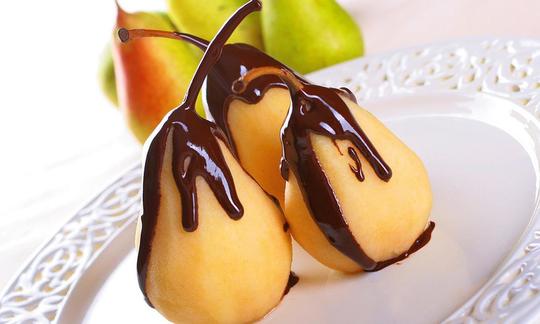

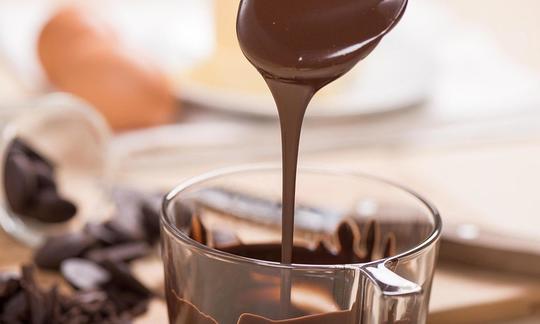

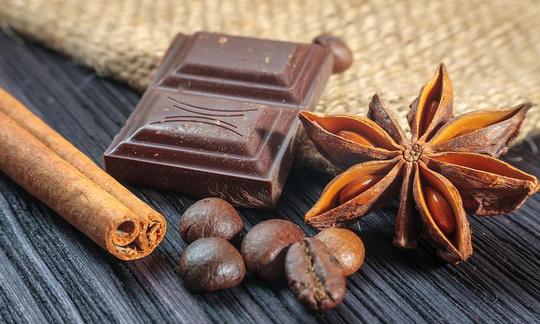

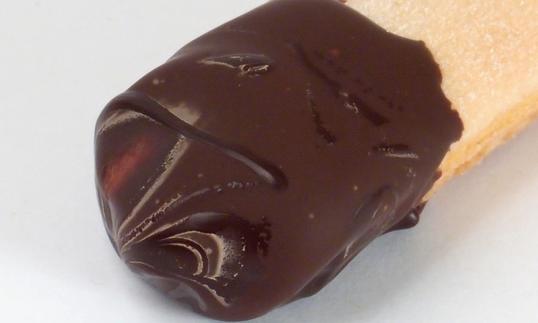

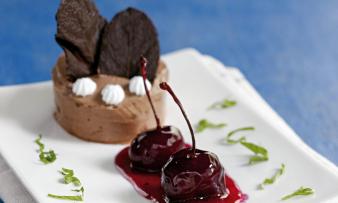





Comments